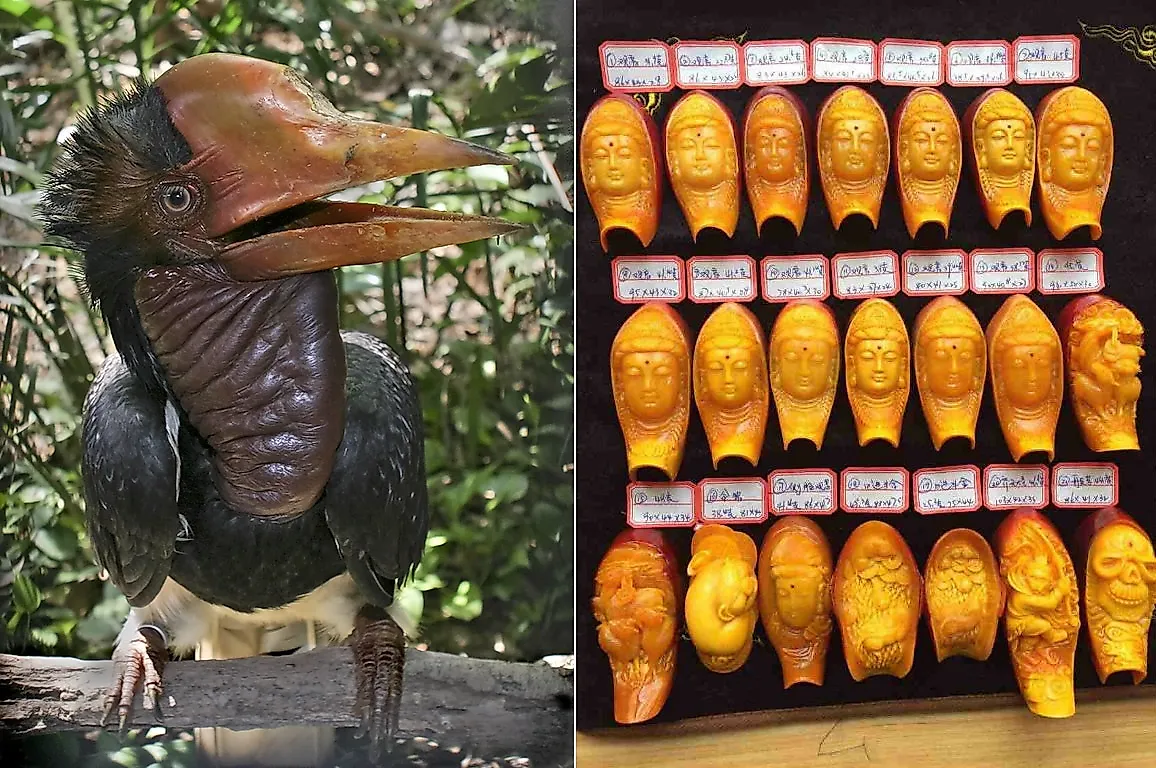What Is Red Ivory, And How Is Its Trade Threatening The Helmeted Hornbill?

5. Meet the Helmeted Hornbill
The "critically endangered" Helmeted hornbill (Rhinoplax vigil) is a rare and unique bird that is found in Sumatra, Borneo, and the Malay Peninsula. The birds are between 110 and 120 centimeters long, with a couple of large tail feathers extending a further 50 centimeters. They possess a blackish plumage on top, with a white underbelly, legs, and tail. The tail feathers have a black band near the tips of each feather. The bird also possesses a bare, wrinkled throat patch, which is red in males and pale blue to greenish in females. The most striking feature of these large birds is their red casque, a helmet-like structure on the head accounting for nearly 11% of the bird’s body weight. The casque is meant for head-to-head combat with rival males, and hence is extremely tough. Furthermore, unlike the casques of other hornbills, it is completely solid in nature. The Helmeted hornbills also use their casque as a digging tool to dig into rotten wood or bark in search of insects and other prey. Fruits such as figs also form an important component of the diets of these birds.
4. The Red Ivory Trade
The casque of the Helmeted hornbill has today pushed this species to the brink of extinction, as human greed and demand for the decorative ornaments and jewelry made from the casques of the hornbill, known as “red ivory”, has led to the widespread slaughter of the members of this species. Culling of the birds for red ivory began as early as 2,000 years ago, when natives of Borneo used to create ornaments out of the casques of killed hornbills. Trade with China began sometime around 700 AD, and continued until World War II, after which it nearly completely declined. Snuff boxes, belt buckles, figurines, and jewelry were just some of the products manufactured from hornbill-derived red ivory during this period. In 2012, however, trade in the red ivory obtained from the helmeted hornbill again commenced in full swing, and the ivory became available on the black markets of Southeast Asia. Furthermore, the fact that red ivory is easier to carve than the white ivory obtained from elephants' tusks and is even rarer to find, red ivory is made an all the more attractive option and serves as a greater status symbol among those of the wealthier Asian communities that are insensitive to the extinction of these grand birds.
3. Unchecked Poaching
The present scenario concerning the helmeted hornbills appears to be very grim. Organized crime syndicates are reported to have spread throughout the forests of Borneo and Sumatra, where locals are employed to shoot each and every hornbill in sight so that at least some of them turn out to be prized Helmeted hornbills. The involvement of locals in the area in the poaching of birds has thus made it highly difficult for the authorities to keep in check these environmental crimes. Over 1,800 casques were seized by authorities in 2010, and the authorities believe that a much greater effort is required to put a check on this widespread poaching of the hornbills.
2. The Severity of the Threat
Today, sufficient data regarding the exact number of the Helmeted hornbills living in their native habitat is lacking. However, from crime report data, some idea regarding the number of birds lost each year can be easily estimated. The hornbill researcher Yokyok Hadiprakarsa drafted a report on helmeted hornbill deaths in 2013 which revealed some truly shocking data. It states that every month around 500 of these birds become the victims of poaching in Indonesia’s Kalimantan province alone. From this it is quite easily understandable that these birds are disappearing at an alarming pace which, if allowed to continue, will lead to the complete demise of these birds in the near future.
1. Conservation Efforts
The Helmeted hornbills need to be saved quickly, as they are of immense ecological significance. These birds are some of the most vital seed dispersers in the forests they inhabit. They also breed only once a year, and produce a single chick in each breeding season. The mother bird stays holed up in a tree hole for five whole months with her chick, depending on the father to bring them both food. The merciless killing of the male birds often keeps the mother and the chick starving for food. Logging in the forests inhabited by the hornbills further impacts these birds, as quite often the trees inhabited by these birds are cut down with them inside.











